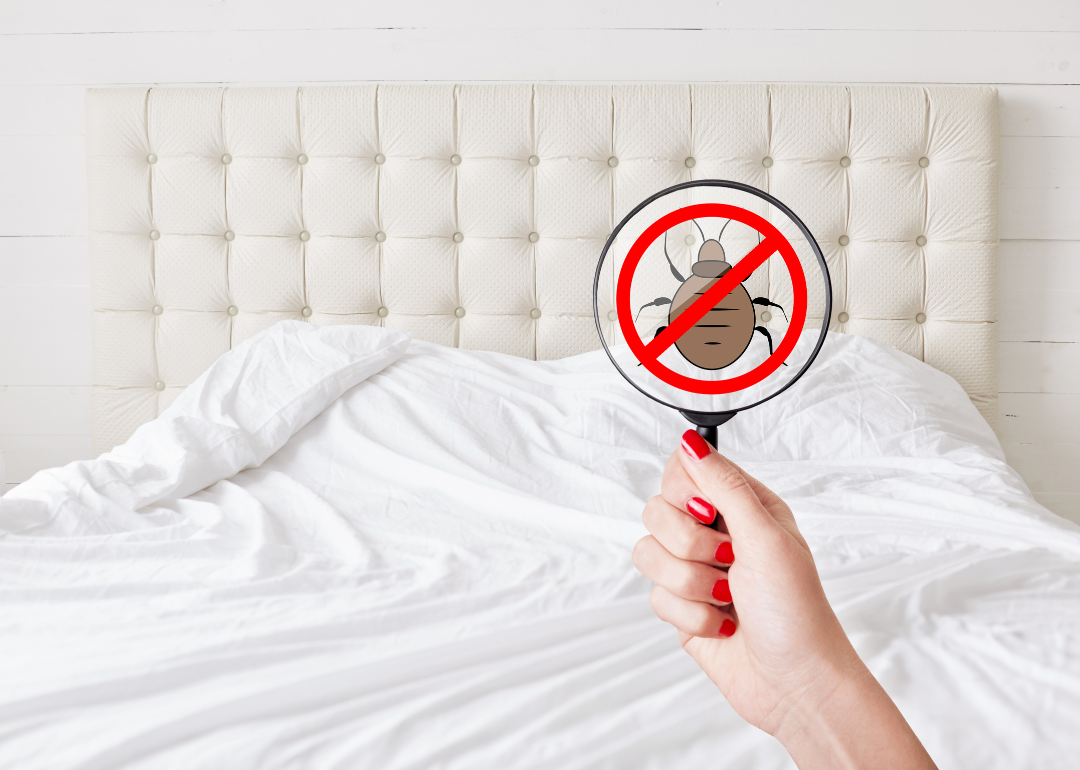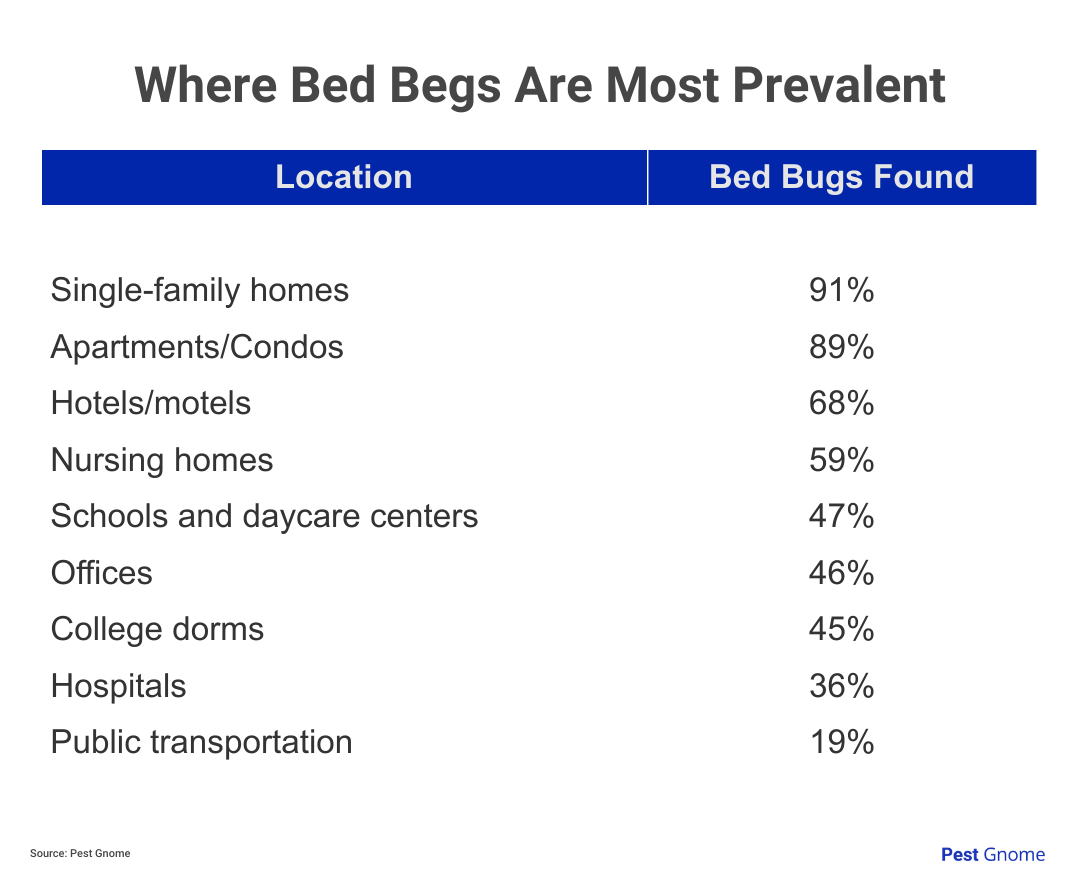
11 ways to prevent bed bugs
How common are bed bugs? One in five Americans have had bed bug problems or know someone who had them, according to The New York Times.
Stories of bed bug-related issues have been in the news many times in recent months:
- Paris bed bug invasion spurs panic, threatens Olympics
- Major Las Vegas Strip hotels battle bed bug infestations
- Hawaii airport closed 3 gates for deep cleaning to remove bed bugs
- New Jersey wedding ruined by bed bugs, lawsuit says
- Chicago is Orkin's bed buggiest city for 3rd straight year
Bed bugs can be a problem in homes, offices, hotels, motels, vacation rentals, dorm rooms, airports (really, just look at the above example in Hawaii), movie theaters, and on public transit.
To prevent an infestation where you live, work, or stay when traveling, Pest Gnome offers 11 ways to prevent bed bugs, along with advice on how to identify them and where they are most commonly found.
1. Don't store items under your bed
Storing items under your bed creates opportunities for bed bugs to hide near your mattress. You may also unknowingly store an infested item.
2. Store items in plastic containers
Bed bugs find it difficult to crawl on smooth surfaces such as glass or plastic. Keep your storage items in a plastic container or plastic bag to help prevent spreading a bed bug problem.
3. Dust mite-proof encasements
Cover your mattress or box spring in dust mite-proof encasements to create a barrier between you and any potential bed bugs.
4. Remove clutter from the floor
Keep your clothes off the floor. If a wandering bed bug latches onto your sweater, you run the risk of that bed bug infesting your dresser or closet.
5. Vacuum regularly
This prevention method helps you remove stray bed bugs. For further prevention, dispose of the vacuum bag in an outside trash can.
6. Keep clothes off the bed
You don't know whose bed these biting pests have infested. It's best to keep your clothes off any beds if you want to prevent bed bugs from coming into your home.
With that in mind, keep other people's clothes off your bed. You never know if they may be transporting a bed bug from their home. Instead of placing guests' coats on your bed, hang them in the coat closet.
7. Inspect your hotel, motel, or dorm room
Before unpacking your clothes in your new sleeping arrangements, inspect the space. Check curtains, the carpet, the walls, and surrounding areas for any signs of bed bugs. Most importantly, check the bed for any signs. If you spot a potential infestation, ask for another room. Avoid placing your clothes on the bed.
8. Wash clothes and luggage after traveling
Ensure your travels don't bring home a bed bug. Immediately wash your clothes and clean any luggage, including suitcases, backpacks, and purses.
9. Wash sheets at the highest temperature setting
About once a week, wash your bed linens at the highest temperature. The heat can help kill bed bugs and their eggs.
10. Keep your bed sheets off the ground
When making your bed or sleeping, make sure your sheets are not touching the floor. A hanging sheet allows a wandering bed bug to crawl up to your bed.
11. Don't pick up furniture from curbs or dumpsters
A free couch on the side of the road can be tempting, but bringing it into your home can lead to a major bed bug infestation. Avoid taking any furniture from curbs or dumpsters, as bed bugs may have infested them.

Where you will find bed bugs
A Pest Gnome analysis found that 85% of all bed bugs are found where their name tells you they will be found – in the bed. As outlined in the chart above, a survey of 5,500 pest control professionals shows where they have most commonly treated bed bugs. Other places where bed bugs are found:
- Couches and office chairs
- Nightstands and dressers
- Curtains and drapes
- Windows and door frames
- Walls, ceilings, and outlet covers
- Your clothes
- Household items
- Floors and carpets
- Hotels, motels, theaters
Where do bed bugs come from?
Although bed bugs have no wings (and therefore can't fly), they are quite the traveling bug. They happily travel from place to place on luggage, upholstery, and from room to room in multi-family dwellings.
The 2018 Bugs Without Borders survey conducted by the National Pest Management Association also found:
- Bites are the most common way that people realize they have bed bugs, representing 92% of the calls to professionals.
- Symptoms of bed bug bites don't appear for 2-3 days, so by the time you are aware of them, you might have a major infestation.
- A whopping 97% of pest professionals treated bed bugs in the previous year.
- Most bed bug complaints come during the summer.
How to check for bed bugs
How do you check for bed bugs? First, you need to round up some gear, know where to look for signs of bed bugs, and learn how to spot signs of an infestation.
Note: Bed bug bites are not a definitive sign of an infestation. Why? Bed bug bites can look like mosquito bites or common rashes. Also, some people do not react to bed bug bites.
Use a flashlight to inspect dark spaces for live bugs, eggs, feces, or molted skin. Eggs are about the size of a pinhead, are pearl-white, and stick to surfaces.
The fecal matter from bed bugs is partially digested blood appearing in clusters of tiny spots, often found on bed sheets. Their feces will soak into the surface and leave behind a black dot, almost like a marker tip.
Bed bugs shed their skin and leave behind a molted, translucent skin shell. The shell looks like an actual bed bug, but empty. They appear in different sizes depending on the life stage of the bed bug.
How to identify bed bugs
Key characteristics to help you identify bed bugs:
- Size: A quarter-inch long
- Shape: A flat, oval-shaped body
- Segments: Three
- Antenna: With four parts
- Color: Brown unless full of blood; then reddish-brown
The cost to treat a bed bug problem
A Pest Gnome pricing guide on bed bug treatment finds that:
- Homeowners pay about $917 to $1,917 for professional bed bug treatment.
- For an infestation that's isolated to one room, an average of $308.
- For an infestation of an entire house, as much as $5,267.
FAQ about bed bugs
Why are bed bug numbers increasing?
● People are traveling more frequently
● Growing tolerance to pesticides
● Lack of awareness and application of preventive measures
Where are places that bed bugs are known to lurk?
Places that are known to be hotspots for bed bugs include:
● Baseboards
● Crevices (remember to seal cracks)
● Electrical outlets
Hiding places include:
● Bed frames
● Luggage racks
● Mattress covers
● Mattress seams
● Secondhand furniture
● Upholstered furniture
● Used furniture
Do bed bugs transmit diseases?
While the bite of a bed bug can leave an itchy red welt, there is no evidence that bed bugs transmit diseases to people.
When do I need to call a bed bug exterminator?
There are so many bed bugs and in so many places that you can expect to have a bed bug problem sometime during your lifetime. Don't wait for an infestation. Follow the common-sense steps above to prevent bed bugs from becoming an issue.
If you already have bed bugs, it's best to call a bed bug exterminator. Some have dogs that can sniff out bed bugs.
And how do you get rid of bed bugs? Steam treatments, extreme cold, pesticides, deep cleanings, and fumigation are just some of the ways pest control pros rid homes, offices, public spaces, and public transit of bed bug infestations.
This story was produced by Pest Gnome and reviewed and distributed by Stacker Media.



